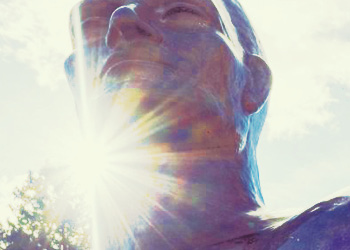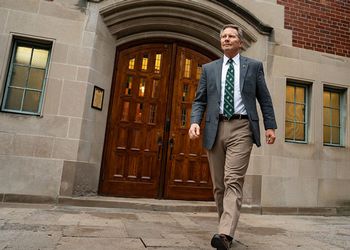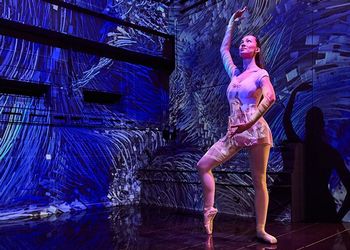Feature: Public Art on Campus

The MSU campus, known for its beauty, has been dramatically enhanced by the addition of some notable works of art.
Ask those who attended MSU to name some favorite memories, and chances are they will mention the beautiful landscape of the campus.
They also will remember some major pieces of art, most notably “The Spartan,” a ceramic statue designed in 1945 by art professor Leonard Jungwirth, later replicated in bronze.
Increasingly, however, much of anyone’s campus experience will include public works of art—especially the works MSU has been displaying since 1999, when the university launched the Public Art on Campus acquisition program.
Impressionist Edgar Degas once described his art this way: “It is not what you see, but what you make others see.” This philosophy underlies much of the MSU plan to ensure that students broaden their horizons as they embark on their journeys of higher education, explains Jeff Kacos, chairperson of the MSU Public Art on Campus committee.
“Students are drawn to academia not just to gain a skill and leverage employment, but also to grow as individuals in ways they did not anticipate or foresee,” says Kacos. “We feel that the campus plays an important role, serving to create a stimulating environment for our exploration and evolution as active, engaged members of a diverse global community.”
Kacos adds that the incorporation of public art into the campus setting serves to increase the vibrancy and cultural richness of the community. “Our goal is to create a unique sense of place and to support our teaching and outreach mission as a world-grant institution,” he notes.
The MSU Public Art on Campus program was initiated by Board of Trustee action in December 1999. The program earmarks a percentage of the construction cost of every new major facility or renovation project to be put toward an art component. Since its inception, 67 individual pieces of artwork have been assimilated throughout the campus, both indoors and out.
A VIBRANT and CULTURALLY RICH COMMUNITY
“Public art is one of those amenities that enhances a community culturally and in turn helps attract a vibrant and diverse population,” says Tom Berding, chair of the Dept. of Art and Art History, who cites the book The Rise of the Creative Class (2002), in which urban studies theorist Richard Florida argues that today’s vibrant work force seeks to live in places that offer unique amenities.
This theme was echoed by Steve Curran and Julie Pingston in the Lansing State Journal (July 2, 2012) when they supported Lansing’s public art investment because, they wrote, “in order to drive economic growth, retain and attract new talent, and create a new economy, we must commit to enhancing our communities by making them more vibrant places to live and to visit.”
Institutions of higher learning across the country understand the importance of maintaining a high-quality campus and the role it plays in attracting diverse and highly-qualified talent, says Berding. “Public art is a central element to this end and is much more than simply ornamentation within the landscape,” he says. “It is central to creating a unique and lasting sense of place.”
PLACEMAKING
University and college campuses across the globe are known for their placemaking. Memorable places are created in individual buildings, a collection of buildings or other unique physical attributes including public art. In a 2010 report prepared by the National Endowment for the Arts, it was noted that, “in creative placemaking, partners from public, private, nonprofit and community sectors strategically shape the physical and social character of a neighborhood, town, city or region around arts and cultural activities…[it] animates public and private spaces, rejuvenates structures and streetscapes, improves local business viability and public safety, and brings diverse people together to celebrate, inspire and be inspired.”
The MSU Campus Master Plan seeks to provide meaningful hierarchy to its vast open space system. It does this by providing a variety of open spaces that serve multiple purposes ranging from group recreation to personal introspection and meditation. Public art allows one to experience and understand a huge campus on a personal scale.
Artwork within the residence halls, academic buildings and campus open spaces all contribute to creating a unique sense of place that the university community can relate to at various levels of scale. Whether it’s Filament gracing the lobby of Brody Hall or Funambulist striking balance in the forecourt of Snyder and Phillips Hall or the tile imagery of campus scenes at Benefactors Plaza, each provides a unique focal point.
EDUCATION AND OUTREACH
Public art also supports social issues of the modern world. The works of Chakaia Booker at the Surplus Store and Recycling Center speak to creativity, diversity and sustainability. Lisa Sanditz’s art in Holden Hall articulates cultural and environmental effects imposed on third-world countries by western civilization. And the work of Glen Michaels in the library reminds us that the past should not be forgotten and can in fact be celebrated through beauty, balance and harmony.
The public art initiative also provides valuable resources for the university’s academic and outreach mission by providing a rich collection of art for teaching and research, bringing a variety of artists to campus for extended discourse with faculty and students, and encouraging social interaction. The collection, comprised of work by artists across the globe, is a true expression of the diversity that is Michigan State University. Eugene Delacroix, a French Romantic artist, postulated: “What moves men of genius, or rather what inspires their work, is not new ideas, but their obsession with the idea that what has already been said is still not enough.” MSU’s Public Art on Campus initiative encourages social interaction, dialogue and intellectual rumination; cornerstones for a populace engaged in higher learning.
What follows are capsule summaries of selected works on campus that were acquired as part of the public art program.
Chakaia Booker – Solar Flare
Surplus Store and Recycling Center
• Since the early 1990s, the artist has worked almost exclusively with tire materials.
• She reclaimed old tires from places like auto repair shops, junkyards and roadsides.
• This unique medium is considered an “aesthetic response to the urban landscape of Northern New Jersey.”
• The tires themselves are often metaphors to satisfy aesthetic, political and economic concerns, in alignment with the mission and goals of the MSU Surplus Store and Recycling Center.
• This artist and art forms were specifically selected for the MSU Surplus Store and Recycling Facility to align with its mission and educational initiatives.
• Chakaia Booker’s career has enabled her pieces to become part of the permanent collections at the Metropolitan Museum of Arts, Akron Museum of Art, The Max Protetch and June Kelly galleries in New York among others. She was represented in the Twentieth Century American Sculpture exhibition at the White House in 1996.
Albert Paley – Cadence
Molecular Plant Sciences Building
• The artist’s work is inspired by the teaching, research and outreach functions of the plant and soil science academy.
• Working with faculty, the artist leveraged his unique artistic style to reflect and suggest the scientific research taking place in the adjacent buildings.
• The sculpture flows through the glass curtain wall signifying a strong tie between the functions of the laboratory and teaching facility with the demonstration and research gardens beyond.
• Albert Paley has been an artist for more than 30 years. He holds an Endowed Chair at Rochester Institute of Technology, is an international lecturer and has authored six books.
Ed Carpenter – Filament Brody Square
• A delicate and crystalline gesture in space, it ascends above the stairway, visible from inside and out, night and day, as an invitation into the building and up the stairs to the community dining area.
• Its form suggests botanical references, and its title derives from the name for the stalk of the anther in the anatomy of a flower.
• Tautly suspended from the main structural elements of the architecture, the sculpture is conceived to be integrated and autonomous, born of the building but strong enough to thrive on its own.
• Ed Carpenter has been creating public, corporate and private projects since 1973, blending art and architecture in large-scale projects.
John Van Alstine – Funambulist Snyder and Phillips Hall
• The term “funambulist” comes from the Latin “funambulus” meaning rope dancer or tightrope walker.
• The artists notes: “This piece exhibits a great sense of balance and choreography. Combined with its association to the sail, it sets up a juxtaposition between the heaviness of steel and the fleeting forces of the wind, creating a compelling visual and intellectual irony.”
• The sculpture aims to connect with the students who make Snyder Phillips Hall their home. “Navigating through college requires students to perform a balancing act while remaining daring, bold and creative,” says the artist.
• John Van Alstine has been widely exhibited in the United States, Europe and Asia, including more than 45 solo exhibitions.
Jae Won Lee – Accrescre II Hubbard Hall
• Her work recalls muted sensibilities of internal reflection through the congruity of Asian philosophy with natural materials but also the incongruity between philosophical tranquility of nature with
contemporary, industry-driven social paradigms.
• The formal and conceptual contradictions demonstrate how basic elements can generate a more holistic relationship between humankind and the natural world.
• Accrescre II features strands of porcelain parts that float in nebulous fields and gather into a narrative or healing force then dissipate to the nonspecific.
• The sculpture depicts a fleeting, floating landscape and a lyrical resonance on the passage of time while conveying the memory of a wintery landscape. The artist has worked to evoke something elusive by reducing the forms to their ultimate necessities.
• Jae Won Lee is an associate professor in the Department of Art and Art History at MSU.
Jonathan and Evelyn Clowes - Cherished Comparative Oncology – Veterinary Medical Center
• The artists’ goal was to create an artistic or sculptural expression that speaks to the program and mission of the
Comparative Oncology facility.
• “We feel this sculpture is an expression of a nurturing and caring gesture toward animals, which is what the Veterinary Teaching Hospital is all about – It’s a compassionate, loving place,” says Evelyn Clowes.
• The central metal sphere, representing the animal kingdom, is gently blanketed by the surrounding net in a nurturing and protective gesture.
Bill Barrett – Twyla Grand River Parking Garage
• This sculpture’s name is inspired by both the artist’s granddaughter Twyla and the professional dancer and choreographer Twyla Tharp.
• The work invokes the artist’s gravitation to the freedoms embodied in Abstract Expressionism.
• Twyla’s expressive gesture hints at fluid movement, human form, grace and balance with an energetic tension visible from all vantage points.
• Bill Barrett, while educated at the University of Michigan now spends his time between New York City and Santa Fe, New Mexico.
Richard Hunt – Sculptural Improvisation II Courtyard south of Chemistry
• Artist Richard Hunt says, “It is my intention to develop the kinds of forms nature might create if only heat and steel were available to her.”
• Although abstract, the sculpture makes general reference to nature, growth, yearning, and reaching for light and life.
• The artist is known for his interest in the morphology and blending of natural and industrial forms.
• Richard Hunt is the recipient of numerous awards and honorary degrees including the International Sculpture Center’s 2009 Lifetime Achievement Award.
Russel Thayer - Wind Rapids III Biomedical and Physical Sciences
• “This sculpture is designed to be a bright arrow pointing to the recessed entry of the building complex that is otherwise invisible to the people or vehicles coming down the street. It is not a sculpture on a pedestal separated from the people only to be looked at, but a piece to be involved with by walking through,” says artist Russel Thayer.
• Its welcoming gazebo-like structure encourages interaction between the people and the artwork; a place of congregation for the building’s visitors.
• Visually, it provides a feathery lyricism on a street of right angles.
• Russel Thayer is one of Michigan’s most respected artists and art educators.
Anne Marie Karlsen – Red Cedar Reflections Case Hall
• The tiles are textured and shaped with a unique ripple-like pattern that catches the light and creates the changing translucence often visible along the banks of the Red Cedar River.
• The image of a tree reflected in the river supports the Case Hall architectural and food venue theme of Michigan.
• The artist states: “As a student, my favorite memories come from the times I spent near the Red Cedar River, which in my mind serves as the heart of campus. The changing seasonal colors of the trees, the light, the flow of water, provide an ever changing and beautiful place to study, paint or just hang out with friends.”
• Case Hall’s role in recruiting and orientation gives it a strong presence as one of the first impressions of MSU and Michigan for many students.
• Anne Marie Karlsen is an MSU alumnus currently teaching at Santa Monica College. Her work has been named one of the Best Public Art Projects in the U.S. by Americans for the Arts and she was included in Art in America’s Best Public Art of 2001.
Steve Troost, ’82, is MSU’s Campus Planner with the Dept. of Campus Planning and Administration. He is a member of the Public Art on Campus Committee.



